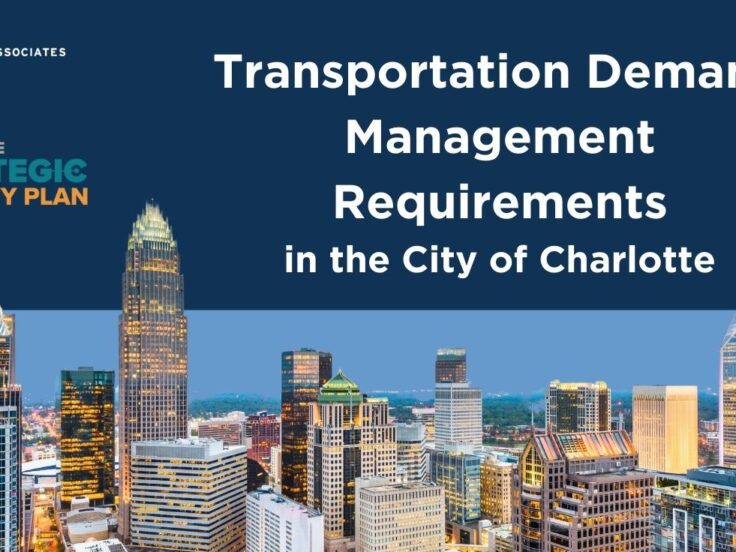ULI Charlotte’s Technical Advisory Panel (TAP) Report, called “Building a Multimodal Future in Charlotte,” explores how to expand the use of Transportation Demand Management (TDM) practices throughout the rapidly growing Charlotte metropolitan region.
Table of Contents (click to jump ahead)
Background: Exploring the Use of TDM Programs in Charlotte
CDOT asked the ULI Charlotte District Council to conduct a TAP to discuss opportunities and challenges of applying TDM tools and measures in Charlotte within the context of land use patterns and the land development process.
The TAP panelists reviewed materials, met with key stakeholders, performed research, and provided guidance on strategies that the city, its regional partners, and the private sector could more effectively use to understand and utilize TDM practices.
ULI Charlotte is a District Council of the Urban Land Institute (ULI). Established in 1936, ULI has more than 45,000 members from nearly 80 countries and is one of the most respected sources of expertise on urban planning, growth, and development. The mission of ULI Charlotte is to complete the ULI experience at a local and regional level through education, research, and the exchange of ideas and experiences.
Why Was the Report Needed?
With the growth of Charlotte, there has been a growing desire to expand the role of TDM to support the region’s growth while creating a more robust multimodal transportation network. At the time of the TAP, Charlotte had experienced a 161.8% population increase since 1980 – growth that “presents several challenges and opportunities related to housing, transportation, environment, social, and other spheres,” as noted in the final report.
Within the sphere of transportation, Charlotte has lacked a comprehensive approach to TDM, including a regulatory framework, benchmarking standards, and policies that would enable the region to implement TDM consistently across development projects.
TAP: Questions and Process
In the lead-up to the panel, CDOT presented participants with key questions to guide their work. These included:
- Effectiveness: What are the most effective TDM tools/measures for Charlotte?
- Application: Where are the places and uses in Charlotte best suited for implementing TDM measures?
- Parking: Is TDM a viable tool to reduce/limit parking demand in Charlotte?
- Neighborhoods: Is TDM a tool for neighborhoods concerned with the lack of offstreet parking in new developments creating spillover into neighborhoods?

The TAP included multiple phases:
- A webinar hosted by ULI Charlotte for the development community: “Easing Gridlock by Connecting Development & Transportation Demand Management”
- A meeting via Zoom for panelists and CDOT staff which included discussion of the Project Briefing Memorandum, background information about planning efforts including the Strategic Mobility Plan, and aspirations for the TAP
process - Interviews with two stakeholder groups including real estate, planning, and development professionals from the local community, and CDOT and other government staff responsible for transportation planning, policy drafting, and ordinance implementation
- A panel work session for panelists to debrief and discuss feedback received, consider potential recommendations, collaborate on research, assign tasks, and prepare the final presentation
- A public presentation for panelists to discuss the purpose of the TAP exercise, feedback received, and potential avenues for CDOT to consider. Panelists also fielded questions and comments.
[continued below]
Related: The Role of TDM in Charlotte's Multimodal Future
Participants in the Technical Advisory Panel
Panelists included:
- Craig Lewis (Panel Chair), FAICP, LEED AP, CNU-A Planning, Urban Design, and Smart Mobility Consultant Principal, Callison RTKL
- Justin Schor Transportation Consultant, Principal, Wells + Associates
- Tom Yardley, Chief Planner, Vice President of Area Planning & Development, MASCO
- Trey Akers, Technical Writer, Senior Planner, Town of Davidson, NC
Panelists met with key real estate and development stakeholders including Eric Applefield with Grubb Properties, Nate Doolittle with LandDesign, Randy E. Goddard, PE with Design Resource Group, Erik Johnson with White Point Partners, Rachel Russell Krenz with Ram Realty Group, Matthew Lucarelli with Beacon Partners, Laura Reid, PE with Kimley Horn, Wells + Associates, as well as key City of Charlotte and Government Partners (including Julian Burton, AICP with CDOT, Robyn Byers with CDOT, Aaron Cook, EI with CDOT, David Harrison, AICP with CDOT, Jason (JL) Lawrence with CATS, Jerrel Leonard, AICP with Charlotte Regional Transportation Planning Organization, Ed McKinney with CDOT, Tracy Newsome with CDOT, Felix Obregon, PE with CDOT, Johanna Quinn with CDOT, Courtney Schultz with CATS, and David Smith with CDOT).
TAP Recommendations
The TAP panelists offered up several recommendations. As the final report stated:
Ultimately, the program’s success lies with the ability to connect TDM to existing citywide transportation and quality of life goals, to develop a flexible program tailored to Charlotte’s unique land use and transportation infrastructure, and to document progress using performance metrics. The program must be adjusted over time based on initial results of pilot programs.
Recommendations included:
- Establish Citywide TDM Policy and Goals: The city should clearly connect TDM to adopted policies, current planning efforts, and aspirational outcomes.
- Designate Point of Contact: The city should designate a point of contact to manage the TDM effort, including coordination with stakeholders and policy developers. This might require updating an existing job description to add TDM responsibilities or creating a new position.
- Identify/Recruit Interested Parties: The city should create a defined stakeholder group to establish baseline metrics, identify tools, and generate a TDM policy/regulatory framework
- Establish Baseline Data Set: The city should undertake the following steps to create a set of performance indicators based on local data, including: identifying metrics, setting targets, designating TDM study areas and candidates, and collecting initial data and analyzing and sharing results.



